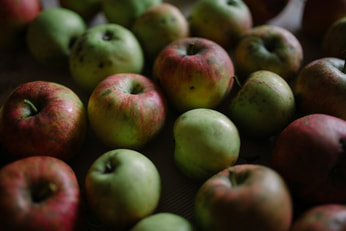 With a general explanation of FODMAPs and the human digestive system covered in Part 1, we have a great foundation set to allow us to move on and take a closer look at each of the FODMAPs specifically and where we commonly find them. Remember, FODMAPs = Fermentable Oligosaccharides Disaccharides Monosaccharides And Polyols Oligosaccharides Oligosaccharides are those carbohydrates with a few sugars linked together (Oligo = a few, saccharide = sugar). In the case of FODMAPs we are talking about a group called Fructans and a group called GOS. Fructans are made up of fructose (a type of sugar) units that are linked together in a chain. We commonly find fructans in grains like wheat, rye and barley and the products made from these grains. Fructans are also found in some fruits like dates and grapefruit and vegetables like onion, garlic and leek. Humans universally lack the enzymes required to break fructans down into small pieces and as discussed in Part 1 we need the contents of our food to be broken down into small enough pieces for us to absorb. Because fructans don’t get broken down they pass through the small intestine and into the large intestine where they are then fermented by bacteria. This process is thought to lead to the growth of more bacteria, primarily bifidobacteria and lactobacilli which are thought to have a range of positive effects in the body. Another byproduct of this fermentation is the production of short-chain fatty acids which are also thought to have positive impacts on human health ranging from improved cholesterol to potentially even effects on mental health. However, perhaps the most relevant byproduct for those with IBS is the production of gases such as methane, carbon dioxide and hydrogen. These gases lead to an increase in pressure in the intestines which can result in some of the common symptoms of IBS. The other oligosaccharides are GOS which stands for galactooligosaccharides. These are found in things like almonds, chickpeas and green peas. How these relate to FODMAPs is similar to the fructans in that humans universally lack the right tools (enzymes) needed to break these down into their simple sugars for absorption. In normal individuals and those with IBS there is the passage of these FODMAPs into the large intestine resulting in fermentation and gas production, the only difference is in those with IBS, in particular, they are more sensitive to these changes in pressure. We also know people with IBS tend to have more issues with moving contents of the gut which can also contribute to the symptoms as when these FODMAPs sit in the gut they tend to pull water in with them too. Disaccharides Disaccharides means two sugars joined together (Di = Two, Saccharide = Sugar). In the case of FODMAPs, we’re talking about lactose which is made up of one molecule of glucose and one of galactose. For lactose to be broken down adequately within the intestines humans must have sufficient amounts of the enzyme lactase. If we do not have enough lactase then lactose remains undigested and again moves through the small intestine and into the large, pulling in water and becoming fermented. It is thought about 10% of the New Zealand population is lactose intolerant, however the rates of lactose intolerance vary greatly between countries. The main sources of lactose are dairy products like milk, soft cheeses, some yoghurts and ice-cream. Things like hard cheese and yoghurt do have some lactose but are generally lower than other products due to the manufacturing process they go through, therefore even if someone has lactose intolerance they may be able to tolerate small amounts of these products. It should also be noted that even those with lactose intolerance have been shown to tolerate some lactose, all the way up to about 12-15g of lactose over the day. Monosaccharides Monosaccharides means just one sugar (Mono = One, Saccharide = Sugar). Concerning FODMAPs this is the sugar fructose and in particular excess fructose. The reason for this is fructose can be absorbed via two different channels, think of these as two roads that fructose can take to exit our intestines and enter our bloodstream. The name of these is GLUT 2 and GLUT 5 transporters. GLUT 5 transporter is specifically for fructose to use however fructose doesn’t like using it as it is slow. GLUT 2 is faster but for fructose to be allowed to use this road it has to share it with another sugar, glucose. Different foods will have these sugars in different ratios, therefore, if we have fructose in excess of glucose there isn’t enough glucose to accompany the fructose via the fast GLUT 2 transporter and so the remaining stuff has to try to go through the slow GLUT 5 transporter. This leads to malabsorption of the fructose as all of it can’t exit our small intestine before it gets moved down our gastrointestinal tract. Due to this, all the same things that happen to our other FODMAPs also happen (pulling in water and getting fermented to produce gas). Foods with excess fructose include apple, honey, mango, pear and asparagus. Polyols This group is also called our sugar alcohol group, containing sorbitol, mannitol, xylitol and maltitol. The main ones we are concerned about are called sorbitol and mannitol. These sugar alcohols are very slowly absorbed in the body by all people and so it is common for those with and without IBS to experience some gut upset from consuming them, particularly when consumed in excess. Polyols are often added to chewing gum or as artificial sweeteners in products, that is also why you will see on some of these products that consuming too much can have a laxative effect. We can also find polyols in some fruits and vegetables like avocado, apricot and mushrooms. Summary There are six main FODMAPs being Fructans, GOS, Lactose, excess Fructose, Sorbitol and Mannitol which are either universally or at least somewhat commonly not absorbed well by humans. This leads to water being pulled into the gut as well as acting as food for the gut bacteria in our large intestine resulting in fermentation and gas production, with the result being an increase in pressure in our intestines. These FODMAPs can be found in a range of foods from fruits, vegetables, legumes, grains, nuts and seeds and confectionery. Look out for part 3 which will cover what IBS is and how the low FODMAP diet is used in IBS. Thanks for reading. Marco
0 Comments
Leave a Reply. |
AuthorWrite something about yourself. No need to be fancy, just an overview. Archives
November 2020
Categories |
